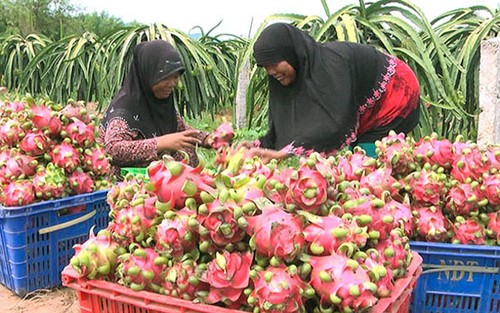|
 Cham villagers in Xuan Hung commune harvest dragon fruits. Cham villagers in Xuan Hung commune harvest dragon fruits.
(Photo: baodongnai.com.vn)
|
90% of the Cham ethnic people in Dong Nai province, more than 2,200 people, live in Hamlet 4. In the past, they had an isolated life and only interacted with each other. This made their lives difficult. Their economy depended on the two annual wet rice crops.
In recent years, thanks to local administration communication and support, the local people have changed their way of thinking and farming, and their economic condition has improved significantly.
Abtukholick's family has more than a hectare of farm land but for many years they remained poor because of outdated farming practices. Four years ago, with local government support, Abtukholick borrowed 4,300 USD from the Vietnam Bank for Agriculture and Rural Development’s district branch to raise cows and converted all his rice paddies into a red dragon fruit garden. Now, the dragon fruit garden brings in more than 17,000 USD anually.
Abtukholick said he has become a model farmer in the Cham village. He recalls:
“Initially I grew just 500 dragon fruit trees. Now I have more than 1,000 trees. Every month one crop gives me an average of 1,500 USD in revenue, depending on the market prices.”
In response to the government’s policy on caring for the Cham people and carrying out new-style rural development, Xuan Loc district has put forth many solutions to improve the Cham people’s lives. The implementation of national poverty reduction programs has breathed new life into the village, whose housing, roads, and water systems have been upgraded or replaced.
All rural roads have been paved. All village households have been supplied with electricity and clean water. Cham villagers have also been given vocational training and provided with jobs, seedlings, breeders, fertilizers, and pesticides. Abdohamit, head of the village mosque, said: “Thanks to the Party and State, our economy has improved. We have good roads, sufficient electricity, and schools so that our children now have the opportunity to study properly. With more companies investing in the locality, our children can have stable jobs.”
Thanks to improved living conditions, the Cham people in Xuan Hung have responded to the movement to build new-style rural areas. Their cultural life has revived. The village’s art troupe has been restored and is thriving. They have been invited to perform at numerous cultural events in Dong Nai.
The achievements of the Cham village can be attributed as much to their solidarity and efforts to better themselves as to the Party and State’s supportive policies.